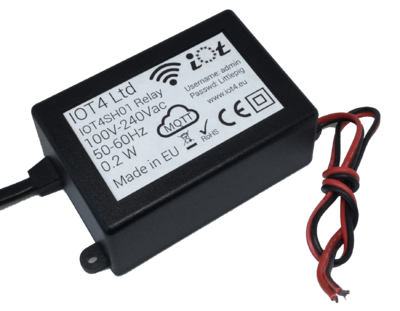IOT4SH01RELAY: Difference between revisions
Jump to navigation
Jump to search
No edit summary |
No edit summary |
||
| Line 5: | Line 5: | ||
===Hardware features:=== | ===Hardware features:=== | ||
*Switchable maximum voltage: 240V AC | |||
*Switchable maximum current: 2A | |||
*Power supply cable length: 1.5m | *Power supply cable length: 1.5m | ||
*Power supply voltage: 100V-240V | *Power supply voltage: 100V-240V | ||
| Line 12: | Line 14: | ||
*Yearly power consumption: 1.8 kWh | *Yearly power consumption: 1.8 kWh | ||
*Dimmensions: 85mm x 55mm x 35mm | *Dimmensions: 85mm x 55mm x 35mm | ||
=== Communication features === | |||
*802.11 b/g/n | |||
*soft-AP | |||
*Up to 5 different networks can be defined | |||
*Supports static IP | |||
*Scans for strongest network if more than one defined | |||
*MQTT enabled | |||
*Domoticz integration via MQTT | |||
*Home Assistant integration via MQTT | |||
*Fast asynchronous HTTP Server | |||
**Configurable port | |||
**Basic authentication | |||
**Web-based configuration | |||
**Relay switching data from the web interface | |||
**Websockets-based communication between the device and the browser | |||
**Backup and restore settings option | |||
**Upgrade firmware from the web interface | |||
*REST API (enable/disable from web interface) | |||
*GET and PUT relay status | |||
Revision as of 12:03, 7 April 2017
IOTSH01Relay series
Hardware features:
- Switchable maximum voltage: 240V AC
- Switchable maximum current: 2A
- Power supply cable length: 1.5m
- Power supply voltage: 100V-240V
- Power supply frequency: 50-60Hz
- Power consumption: 0.2 W
- Power supply protection: double protection
- Yearly power consumption: 1.8 kWh
- Dimmensions: 85mm x 55mm x 35mm
Communication features
- 802.11 b/g/n
- soft-AP
- Up to 5 different networks can be defined
- Supports static IP
- Scans for strongest network if more than one defined
- MQTT enabled
- Domoticz integration via MQTT
- Home Assistant integration via MQTT
- Fast asynchronous HTTP Server
- Configurable port
- Basic authentication
- Web-based configuration
- Relay switching data from the web interface
- Websockets-based communication between the device and the browser
- Backup and restore settings option
- Upgrade firmware from the web interface
- REST API (enable/disable from web interface)
- GET and PUT relay status
